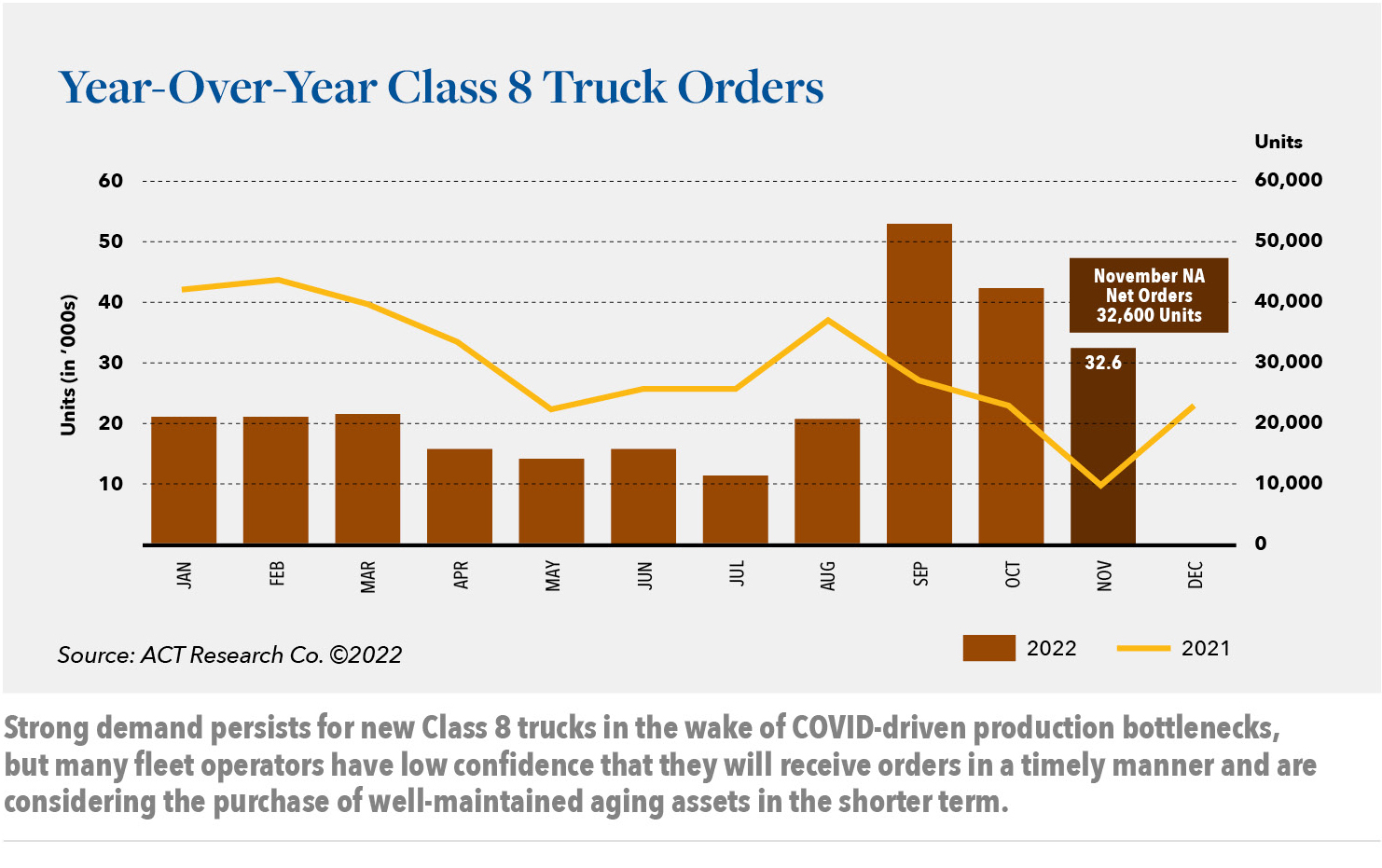Where the Class 8 Truck Market is Heading in 2023

Unprecedented capacity constraint in the class 8 truck market during the period from 2021 through 2022 was something shippers and carriers involved in the industry knew was a temporary development. As in any market, however, the only certainty about a given snapshot in time is that it is certain to change. Now, as we approach what most believe is the tail end of a period in which North America saw demand and lack of supply like no other stretch in modern history, it is worth looking back to understand where the market stands today and what can be expected moving forward. Below is a summary of how the used class 8 truck market has been impacted over the past few years, how that period can be compared and contrasted to the Great Recession, and what we can expect 2023 to bring.
How Does the Current Period Compare to the Great Recession of ‘08/’09?
At Hilco, our team works extensively in lockstep with commercial lenders, ABL shops, equipment finance entities, private equity firms and operators. In addition to delivering appraisals, we are often asked to candidly share our thoughts and insights regarding current market conditions/developments in relation to what we have observed and tracked historically in a given industry. This was particularly evident during this most recent cycle, where our discussions with both new and long-established clients invested in the transportation space reached much further back than just pre-pandemic 2019. Many, for example, wanted to know how today’s market compares to the mortgage crisis and Great Recession of 2008/2009 and what lessons can be brought forward from that period and applied today.
In terms of cyclical values in the transportation space, there have always been normal variances with peaks and troughs in supply and demand, and high and low values. While there are certainly some meaningful connections that can be drawn between the period of the Great Recession and what we have recently experienced as a result of the impacts of COVID-19, from a macro perspective there are not a great number of similarities between the two occurrences in regard to the domestic transportation market.
Going into 2008, U.S. commercial transportation was very strong and likely near a cyclical peak. Truck and trailer values were inflated with equipment selling at a premium. No one could predict at the time that values were primed to take a steep and rapid dive. That, however, is exactly what they did– to the tune of roughly 30%-40% on transportation assets and many other industrial asset categories. So much emphasis has been placed on the impacts to residential housing at that time that it is quite easy to forget that many other aspects of the economy experienced a “bubble” pop as well.
In tracing what occurred moving forward from that point, we see that after what felt almost like an overnight correction in the used commercial transportation space back in 2008, the following years yielded a gradual and steady value recovery. So much so that by 2019 it was looking like the market was approaching a normal trough that, by all accounts, appeared to be a low water point in the normal ebb and flow of multiyear market behavior. And, in fact, 2019 did see lower demand, lower values, a surplus of assets in the used market, and a cautious stance by OEMs. This pre-pandemic state was essentially the opposite stage in a rolling ebb and flow concept as compared with the inflated asset values that we experienced directly before the crash of 2008. So 2019 was a low, but not alarmingly low, point in the cycle with the prevailing outlook at the time being that the market could go nowhere but up. Herein lies the crucial differentiation between the pre-recession and pre-pandemic transportation markets.
A Closer Look at COVID’s Impacts on Trucking and Truck Values
As the pandemic spread around the globe, we experienced a near stop in OEM production followed by labor and parts shortages, price increases, inflation and higher spot pricing. This caused used Class 8 truck prices to skyrocket and supply in both the new and used market to become extremely sparse, making the period from Q1 2021 through Q2 2022 the ultimate seller’s market. Essentially, if a seller had a truck that could run, someone was willing to pay over odds for it during that time. With new equipment largely unattainable, standard utilization parameters for fleet operators were – and continue to be – elongated, and many companies have found themselves keeping vehicles on hand well beyond typical aging and utilization comfort levels. Along with this development, service and maintenance cadences have been strained as well. After all, how can operators effectively upkeep fleets that grow older and become more worn out when parts and components are in such low supply and on backorder? In the end, maintenance suffers as only the most crucial and core repairs can be made while other less critical items are deferred.
How did this all affect the used truck market? In the supercharged pandemic world, overwhelming consumer demand perpetuated by supply chain and labor constraints catapulted the nation’s carriers, both small and large, into an incredibly profitable window of opportunity. Those that had the fleets to take advantage of spot rates were in an enviable position. But OEM’s, amid diminished resources, were unable to meet unprecedented demand and, as referenced earlier, new truck customers were forced to look to the used market and extend the useful life of their existing fleets. This climate, in turn, created a highly competitive used truck market driving values at or above retail and carriers came to terms with purchasing used equipment at a premium. It wasn’t until the end of Q1 2022 that the average sale price reached its peak.
No Party Lasts Forever and Everyone Knows It
From the peak of average used values being roughly 80% more than customary depreciation cycles at around mid-year 2022, several factors went to work in a consistent and predictable downward correction that ran its course through the end of Q4. From soaring diesel prices and inflation, the war in Ukraine, the easing supply chain, consumer debt, and the cooling labor market, to cratering consumer confidence and lack of access to capital, you could almost hear the air come out of the market as it began to return from the stratosphere back to some semblance of normalcy.
Even with this fall, the market today is still stronger than it was at the end of 2019. Used pricing for class 8 truck tractors is currently outperforming wholesale and auction values for the same vintage of assets from that time, despite 2+ years of aging and utilization. The end of the year is always a trying time for used trucks values, with prices typically falling up to 15% in December as model changes are introduced. Though the used truck market saw a decline in average sales price from November to December 2022, values still average 50% above those seen in December 2019.

What Can be Expected Moving Forward?
The U.S. is arguably already in a recession, albeit a much milder one than in 2008. While the transportation space has been impacted, we believe there is still plenty of room to run for softening of resale values and expect a continued correction to take place through the first half of 2023.
With numerous macro factors presently in play that do not typically exist all at the same time, there is a tug of war afoot within the industry when it comes to used values. Carriers have started feeling the hangover after two years of record profits as they ease into a more normal, cautious course of business where profitability returns once again to that fluctuating ebb and flow. This will, of course, be reflected in used values. Meanwhile, we can expect to see companies which have been extending the useful life of their trucks begin to release that equipment into the marketplace in increasing volume. With higher mileage and less comprehensive servicing conducted over the past two years, buyers are not likely to be clamoring over these units. Instead, we should anticipate that they will behave shrewdly in their assessment of each truck that goes to market. Different fleets going to market may look the same on paper but buyers will drill down into the details. Better maintained fleets will yield stronger returns while fleets with obvious deferred maintenance will suffer when taken to market. With used truck dealers cautiously re-entering the wholesale market, values will feel the pinch. Aged equipment with high miles will be significantly impacted with slow softening also affecting later model equipment as well. Negative value adjustments will be compounded by the high cost of capital and the softening freight market, as used trucks make their way down from 2nd and 3rd tier operators to much smaller regional and local operations.
It is worth noting that there are still some looming challenges within the supply chain, including parts manufacturing. While semi-conductors may no longer be the hot-button issue in the press, availability remains a challenge for new truck production. This places a continued reliance upon, and demand for, good used trucks. The key word here is “good,” and we strongly believe well maintained inventory that set’s itself apart will be greatly valued moving ahead.

During the high demand/low capacity period we have been discussing here, transportation operators were restricted from doing the one thing they typically do with record profits, which is to purchase more new trucks. While this clearly frustrated manufacturers, they did manage to capture a sliver of the pie through increased cost of goods and they now also have a very healthy backlog of orders on tap. In fact, new Class 8 truck orders in 2022 finished ahead of ACT Research’s forecast and well outpaced those in 2021, with order cancellations at below 1%. This, of course, means that the truck market is still constrained, and those companies that are in the market for new fleet will likely still splash cash in the used space in lieu of waiting too long for new production.
Ultimately these opposing factors should lead to a more steady softening of used values vs. a feared dramatic and unmanageable drop in market conditions. We expect to see less volatility and to some extent, a return to a pricing trough that is reflective of the pre-pandemic used trucking marketplace of Q3 and Q4 2019. While new pricing and access to affordable capital remain at their current highs, late-model, well-maintained, low-mileage trucks will command a premium. And while it is not completely clear how the production pause that was created by most OEMs shutting down for roughly a year during COVID will be reflected in used values during the period ahead, it is logical to expect that there will be a material gap (or a bit of a shelf in pricing) between pre-pandemic vintage assets that remained on the road and incurred higher mileages and less consistent maintenance vs. units produced in or after the 2021 model year.
Hilco Valuation Services is one of the world’s largest and most diversified business asset appraisers and valuation advisors, and the largest in the market-driven value space. A trusted resource to countless companies, their lenders and professional services advisors, the company provides value opinions across virtually every asset category imaginable, including extensive expertise across transportation, construction, material handling and related asset categories. Our proven track record in liquidation of fleet assets and direct investment in the ownership and operation of trucking and over the road fleet leasing companies makes Hilco uniquely adept at understanding current markets and how they affect asset value.





